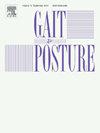Different types of mastoid vibration induce different responses to ground reaction force during walking: An exploratory study
IF 2.4
3区 医学
Q3 NEUROSCIENCES
引用次数: 0
Abstract
Background
Mastoid vibration (MV) helps detect changes in spatial-temporal gait parameters and margin of stability, allowing researchers to study how sensory input influences motor control strategies. Additionally, ground reaction force (GRF) measurement has widely emerged as a more accessible alternative to camera-based motion capture systems for detecting balance control in healthy and pathological groups in smaller clinical settings.
Research question
Would different MV affect the GRF parameters in healthy young individuals?
Methods
Twenty young adults experienced MV unilaterally or bilaterally during walking to temporarily disrupt vestibular function. Dependent variables included amplitude of GRF peaks, time-to-peaks, and respective variabilities in anterior-posterior, medial-lateral, and vertical directions during weight acceptance (initial contact to loading response) and push-off (terminal stance) phases.
Results
A significant effect of MV was found in the amplitude of GRF peaks in the AP (F2, 38 = 20.607, p < 0.001) and in the ML directions (F2, 38 = 20.607, p < 0.001) during the weight acceptance period. In the AP direction, bilateral MV reduced amplitude of GRF peaks more than no MV (p < 0.001) and unilateral MV (p = 0.002). Unilateral MV increased ML GRF peak amplitude when compared with the application of no MV (p = 0.001) or bilateral MV (p = 0.024). MV didn’t affect the time-to-peak of GRF between conditions.
Conclusion
These observations suggested that different types of MV induced different patterns of GRFs and respective variabilities. This foundational knowledge paves the way for developing new methods to identify and diagnose specific vestibular disorders.
行走时不同类型的乳突振动对地面反力的响应不同:一项探索性研究
乳突振动(MV)有助于检测时空步态参数和稳定边缘的变化,使研究人员能够研究感觉输入如何影响运动控制策略。此外,地面反作用力(GRF)测量已经广泛出现,作为基于相机的运动捕捉系统的更容易获得的替代方案,用于在小型临床环境中检测健康和病理组的平衡控制。研究问题:不同的MV是否会影响健康年轻人的GRF参数?方法20例青壮年在行走过程中出现单侧或双侧中压,前庭功能暂时受损。相关变量包括在负重接受(初始接触到负载响应)和推离(最终站姿)阶段,GRF峰值的振幅、到达峰值的时间以及前后、中外侧和垂直方向上各自的变量。结果MV对体重接受期AP方向(F2, 38 = 20.607, p <; 0.001)和ML方向(F2, 38 = 20.607, p <; 0.001)的GRF峰幅有显著影响。在AP方向,双侧MV比无MV (p <; 0.001)和单侧MV (p = 0.002)更能降低GRF峰的幅度。单侧MV较无MV (p = 0.001)或双侧MV (p = 0.024)增加ML GRF峰值幅度。不同条件下,MV对GRF的峰值时间没有影响。结论不同类型的MV可诱导不同类型的GRFs及其变异。这一基础知识为开发识别和诊断特定前庭疾病的新方法铺平了道路。
本文章由计算机程序翻译,如有差异,请以英文原文为准。
求助全文
约1分钟内获得全文
求助全文
来源期刊

Gait & posture
医学-神经科学
CiteScore
4.70
自引率
12.50%
发文量
616
审稿时长
6 months
期刊介绍:
Gait & Posture is a vehicle for the publication of up-to-date basic and clinical research on all aspects of locomotion and balance.
The topics covered include: Techniques for the measurement of gait and posture, and the standardization of results presentation; Studies of normal and pathological gait; Treatment of gait and postural abnormalities; Biomechanical and theoretical approaches to gait and posture; Mathematical models of joint and muscle mechanics; Neurological and musculoskeletal function in gait and posture; The evolution of upright posture and bipedal locomotion; Adaptations of carrying loads, walking on uneven surfaces, climbing stairs etc; spinal biomechanics only if they are directly related to gait and/or posture and are of general interest to our readers; The effect of aging and development on gait and posture; Psychological and cultural aspects of gait; Patient education.
 求助内容:
求助内容: 应助结果提醒方式:
应助结果提醒方式:


